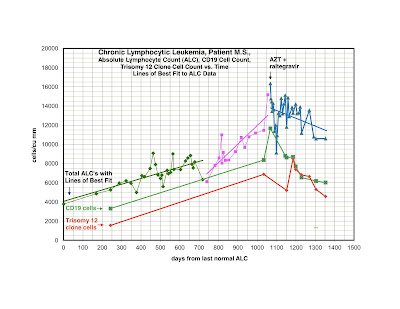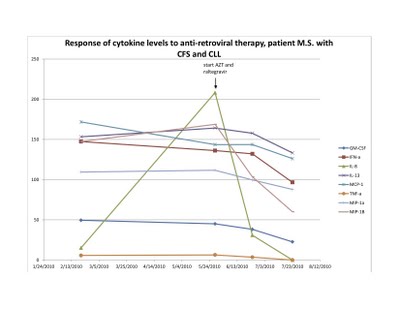I knew when I posted something positive about the use of oxygen for ME/CFS, I would hear about Dr. Cheney’s views on oxygen toxicity, just as I heard about his views on the use of Klonopin, when I said that I am opposed to any avoidable use of long term benzodiazepines (understanding full well that sometimes it can’t be avoided). I disagree with Dr. Cheney about a lot of things. Gasp! And agree with him about others. I am in the process of launching a Physician Working Group for the WPI and Dr. Cheney will of course be invited. It is wonderful that he and I can disagree and are going to work together to figure it out. There are going to be lots of other people who disagree with me, and each other, about many things. In fact, I’d say, there is absolutely zero chance for consensus in the group I’m putting together, but I am hoping for a melding of minds, nevertheless, for the betterment of patients. One thing I am sure of, we all want the same thing, to help people get well.
My understanding, from email communication with Dr. Cheney some time back, is that he is looking at one parameter, IVRT, of one organ, the heart, by echocardiogram, after administering low-flow oxygen by nasal cannula, as well as exposing patients to other substances in sequence. If I put an oxygen cannula on your face, at a time when you are under stress, and your IVRT, a measure of diastolic function gets worse, what does that mean? Hyperoxia causes vasoconstriction in normal tissues, so a compromised circulatory system might look worse at that moment. So what? I talked about and referenced all the reasons why repeated exposure to higher than normal amounts of inspired oxygen might be a good idea over the long haul, even if the treatment produces a few more free radicals than usual, for which antioxidants can be given. Free radicals are necessary for life, involved in intracellular killing by phagocytes and redox signaling. In hyperbaric wound care, high doses are needed to produce free radicals to kill bugs.
Dr. Cheney described a reaction to oxygen, in which patients become anxious or even obtunded, which I don’t understand. I administered very large doses of oxygen to chronic Lyme patients, who in hindsight had ME/CFS, and lots of patients with other diagnoses, including a couple of post-stroke COPDers with CO2 retention, and never saw anything like what he described, even in a very claustrophobic environment, the inside of a multiplace hyperbaric chamber, that looked kind of like a submarine (link to photos here and here of our chamber at New England Hyperbaric Center 1999). Nor did I ever see anything like that in many years of high volume emergency medicine practice, except in acutely decompensating chronic COPD patients.
The idea that the cells of ME/CFS patients utilize oxygen in such a different way from all other animal cells such that doses safe for other humans would somehow be dangerous for us seems ludicrous to me. I’ve gotten a bunch of confused mail about how ME/CFS patients have “high oxygen” already and more is toxic to them. CFS patients have normal oxygen saturation, O2 Sat, in the blood, meaning the carrying capacity of hemoglobin is normal. Oxygen travels from the arterial blood into cells by diffusion along a pressure gradient. The issue in ME/CFS is cellular hypoxia, meaning the interior of the cells are starved for oxygen and the mitochondria can’t generate ATP properly, due to poor mitochondrial function. So no gas in the tank. The mitochondria are the energy factories of the body and they are mucked up, still producing enough energy for life through the same chemical processes utilized by all eukaryotic cells, but with an inadequate supply of substrates necessary to generate ATP, and inadequate reduced glutathione to prevent damage by free radicals and other reactive oxygen species. Sometimes I wonder if it is more diabolical than gunked up machinery, that the virus doesn’t like oxygen and therefore causes the host not to be able to move. I presented the evidence in the literature for the use of oxygen in autism. Since I believe autism is essentially the same disease as ME/CFS acquired earlier in life, with the same mitochondrial problems, it seems logical to try mild HBOT for ME/CFS, especially in light of the very low risk of harm.
At the time that I left hyperbaric practice, I was worried about the possibility of an explosive decompression, a potentially lethal event, in a soft chamber, as they are not rated for hundreds of compression cycles. I was opposed to home treatment on that basis, not because of any inadequacy of the treatment. Since then, my understanding is that there have been more than 10,000 FDA approved soft chambers sold, and the thing I was fearing hasn’t happened. If they leak, they give at the zipper and don’t lose pressure suddenly. The only serious accidents have been related to modifications made to allow higher than rated pressures. There are risks, even to mild hyperbarics, and nobody should undertake it without training from a professional, but it’s not that hard, once you get the hang of the concepts.
Whatever is happening with respect to the length of diastole when oxygen is administered, it seems to me that we should be worrying more about the brain than the heart in light of the clinical course of most patients. The brain is very sensitive to ischemia. Whatever the oxygen saturation in the blood, ischemia can be present downstream of vascular spasm. That’s what I was addressing with some of the literature I posted. Not that we are having strokes, but that some of the cognitive issues may come from repeated localized ischemic insults, mini TIAs (transient ischemic attacks), during periods of vascular spasm. It seems rational to me to combat that with oxygen.
This is a blog, evolving opinion, not a statement of fact. I am sharing my thoughts, before even trying things in the present context, before proving anything. I am, however, putting my money where my mouth is, and I will continue to share our unfolding experiment in real time. I do this, not because I am trying to convince anyone that I am right. I could be wrong about anything. I am sharing my thinking as it happens, because we are in uncharted territory and there is so much suffering and desperation. None of us have years to waste. I have experience to tap in to and there is shockingly little information available when considering options. But at no time am I suggesting that anyone else should do what we are doing.
I posted our planned infusions, before knowing the outcome, as I’ve done all along with everything. Some of it for me is an attempt to learn from others, because patients and doctors write to share their experiences and ideas. We have done similar infusions in the past that were not noticeable or effective, concurrent with antibiotics for Lyme Disease. We did our first infusion of the formula I posted yesterday and we are working out the kinks with our doctor. Surprisingly, at least to me, we did feel it, Ali positively, me, not so positively thus far. I’ll let you know. I don’t want to start tweeting, but I put it out there last post thinking that it could only be positive or nothing, and I may want to reconsider that, though I still expect that any adverse effect would be mild and temporary. My sleep was disturbed last night and I was kind of wired today and not as stable as I have been. My guess is that it was from the Leucovorin, a folic acid derivative, the only component I haven’t been exposed to before. Deplin can cause similar adverse reactions which are dose related. I find it encouraging that the infusion was noticeable to both of us, but the formula needs tweaking.
As you might expect, I’ve been doing a lot of thinking about MCS these days, at least in the form that Ali is having it. I was speaking to the father of a patient today who is having severe light and sound sensitivity, much like the very severe patients in the UK and Norway. Ali is being triggered by smells, even natural smells like essential oils. My light bulb for today was that these problems are all very similar, all extremely heightened responses to different sensory stimuli. My first symptom was heightened and altered sense of taste. Many patients, and autistic children, have problems with touch, can’t stand tags in clothing, are hypersensitive to light touch, etc. I suspect it’s a kindling phenomenon, less than seizures, but similar, a little less than a full blown disease, as often happens in ME/CFS. Networks of neurons are being synchronized inappropriately by sensory triggers. Repeated stimulation leads to threshold reduction. I am not saying that biotoxins or petroleum products aren’t the trigger for some, but it doesn’t look to me like that’s what’s happening to Ali. It changes my thinking about how to approach it. If it’s a problem with detox and being unable to handle total toxic burden, one set of possible solutions, but if it’s being set off by smells, it’s the response that needs to be attenuated. I am not saying that we aren’t decontaminating and restructuring things so that she can avoid being triggered, which is a big task for an already over-taxed family, but it isn’t possible to be in the world and avoid smells. It is making me think about neurofeedback again. Another topic for another day…


